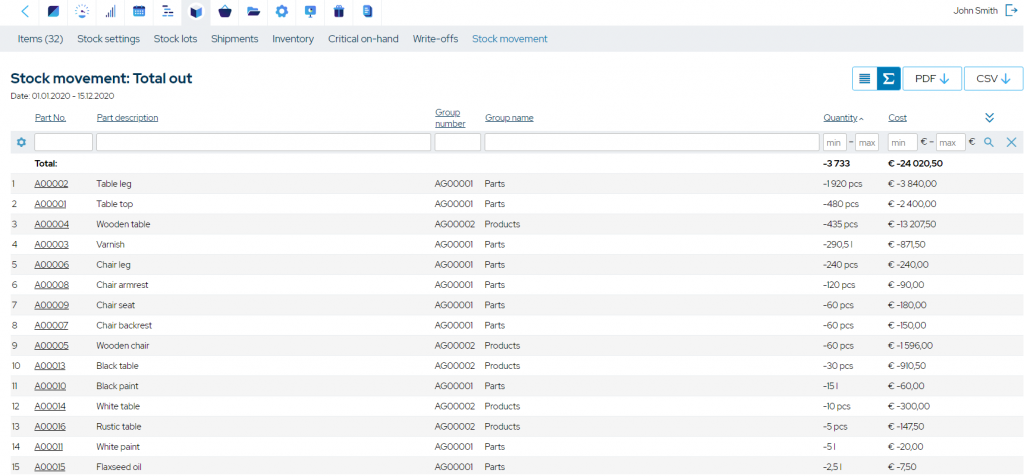Inventory Turnover Ratio – Formula, Examples, and Tips
The inventory turnover ratio is a good indicator of your sales and inventory management performance. Find a balance between sales and stock by using these formulas and tips.

What is the inventory turnover ratio?
The inventory turnover ratio (ITR) is a key performance indicator that measures how efficiently a company manages its inventory. Specifically, it shows the number of times a company’s inventory is used and replaced over a given accounting period, often a year. This ratio is calculated by dividing the cost of goods sold (COGS) by the average inventory for the period.
While in retail and distributing environments, only finished goods flow in and out of inventory, in manufacturing, the inventory accounted for when calculating the inventory turnover ratio includes finished goods, raw materials, and work-in-process goods.
Inventory turnover ratio measures the performance of the business – if the inventory turnover ratio is high, then usually goods are sold quickly and the company carries little to no excess inventory; if inventory turnover is low, sales might be weak and there could be a large amount of excess stock.
Thus, it is a reflection of how effectively the company caters to the market, and how efficient it is in inventory management.
There is a balance, however, to be found when managing inventory. If the company’s inventory turnover is very high, then it might be an indication of inadequate inventory levels, which could cause missed business opportunities due to not being able to fill customer orders.
Conversely, a low ratio could signify either weak sales or overstocking, which will negatively affect your bottom line, the former by not bringing in revenue, and the latter by tying up cash that could be used elsewhere.
Therefore, the inventory turnover ratio is also a good indicator of the level of synchronization between the sales and procurement departments.
Why is the inventory turnover ratio important?
As mentioned, the inventory turnover rate is one of the best metrics to assess both your inventory and supply chain management effectiveness as well as your overall business performance. Here is how keeping an eye on your stock turnover allows you to detect issues and improve your business.
Optimized cash flow
A high inventory turnover ratio means you’re quickly converting your inventory into sales. This promotes better liquidity and cash flow, allowing you to free up working capital for other critical business investments.
Meeting customer demand efficiently
Tracking the ITR ensures not just meeting but optimizing for customer demand. Keeping the ratio balanced means you will have enough inventory to satisfy your customers while not overstocking and risking obsolescence.
Guard against obsolescence
A low turnover ratio serves as a warning signal, allowing you to take preemptive action before inventory becomes dead stock. This foresight can save both money and storage space, making your operations leaner and more cost-effective.
Higher profit margins
By focusing on your ITR, you minimize the chances of holding onto unsold or obsolete inventory that is at risk of becoming dead stock. Reduced warehousing costs and less waste contribute directly to higher profit margins.
Better financial modeling
If your ITR doesn’t align with the benchmarks in your industry, it may point to flawed financial modeling. Perhaps your sales forecasts are too optimistic or your procurement costs too high. Such discrepancies can adversely affect your profit margin and should be corrected promptly. Tracking the ITR can help you identify errors in your financial modeling and to correct them.
Inventory turnover calculation
Calculating the inventory turnover ratio for a given time period is quite simple, provided that you have accurate data available.
Specifically, you will have to know the cost of goods sold (COGS) and the average inventory value of your company.
The cost of goods sold comprises the direct material and labor, and overhead costs incurred in manufacturing the products a company sells. It does not account for other costs such as those for distribution, marketing and sales, or administrative expenses.
Average inventory is used due to seasonality, i.e. companies having different inventory levels during different times of the year – for example, high levels right before holiday shopping, and low levels at the start of the year.
It’s the average value of inventory within a set time period, calculated by taking the arithmetic mean of the beginning inventory and ending inventory values.
To get the inventory turnover ratio for a particular accounting period, just divide the COGS with the average inventory value.
Example
Let’s consider a hypothetical company.
For the fiscal year 2022, the company reported the following numbers:
- Cost of goods sold (COGS): $500,000
- Beginning inventory: $50,000
- Ending inventory: $70,000
Calculation
First, they calculate the average inventory for the year:
Average Inventory = (Beginning Inventory + Ending Inventory) / 2
Average Inventory = ($50,000 + $70,000) / 2= $60,000
Next, they calculate the inventory turnover ratio using the following formula:
Inventory Turnover Ratio = COGS / Average Inventory
Inventory Turnover Ratio = $500,000 / $60,000 = 8.33
Analyzing the result
The company has an inventory turnover rate of 8.33. This means they sold and replaced their inventory approximately 8 times during the year.
- Efficiency. The high ratio indicates strong sales and effective inventory management.
- Liquidity. The high turnover positively impacts their balance sheet, suggesting good liquidity and cash flow management.
- Customer demand. The ratio suggests that they’re maintaining enough inventory to meet customer demand without the risk of unsold or obsolete stock.
The company should now compare this ratio to industry benchmarks to determine how well they’re performing in relation to competitors. This comparison will not only validate their performance but also help in financial modeling for future inventory management.
Days sales of inventory
Days sales of inventory is a similar concept to the inventory turnover ratio, one that measures the number of days it takes to sell the inventory at hand.
It puts the inventory turnover ratio into an easily comprehensible perspective: how long will it take to sell the goods that are currently in stock?
To calculate it, just flip the inventory turnover ratio formula and multiply it by 365.
Example
As a refresher, the company had the following values for the fiscal year 2022:
- Cost of goods sold (COGS): $500,000
- Average inventory: $60,000 (calculated above)
The formula to calculate days sales of inventory is:
Days Sales of Inventory = Average Inventory / COGS × 365
Calculation
Using the formula, the company can calculate their DSI as follows:
Days Sales of Inventory = $60,000 / $500,000 x 365
Days Sales of Inventory = 43.8
Analyzing the result
A DSI value of approximately 44 days means that, on average, it takes the company about 44 days to sell its entire inventory.
- Cash flow implications. This gives them a better understanding of their cash flow cycle, knowing that their money is tied up in inventory for about 44 days.
- Working capital. Understanding the DSI aids in managing working capital, allowing the company to allocate resources more effectively.
- Customer demand. With this information, the company can further fine-tune its inventory levels to better align with customer demand cycles, particularly if the products are seasonal.
Knowing both the inventory turnover ratio and days sales of inventory enhances the company’s financial modeling capabilities. This dual knowledge allows them to optimize inventory levels in a way that both maximizes sales opportunities and minimizes costs.
What is the ideal inventory turnover ratio?
Generally speaking, there is no universal ideal inventory turnover ratio – the perfect ratio varies industry by industry, product to product.
If you produce fast-moving consumer goods like food or drink items, or other perishables, then your ITR should be much higher than, for example, a company that builds custom furniture.
Even though some sources say a good inventory turnover ratio in any given company would be between 4 and 6, some say that it would be between 5 and 10, you can find the ideal number for your business only by analyzing your own inventory and sales.
How to improve your inventory turnover?
Inventory turnover can be improved with many different strategies, which generally fall under the jurisdiction of sales, marketing, inventory, or procurement management. The best results can be achieved, however, by fine-tuning all of the areas at the same time.
1. Collect data and use forecasting
Use an MRP system or inventory management software to collect and analyze data regarding your inventory – about what sells and what does not. This data will allow you to better predict and understand customer trends, develop a better procurement strategy, identify stock that has become obsolete, and increase inventory turns. While data collection can be done with Excel or other spreadsheet applications in the initial stages of the business, mature companies that are looking to scale should consider moving on to designated software.
Read more about Demand Forecasting and What MRP Software Can Do With It.

2. Develop your marketing strategies
Manufacturers often think that marketing is not for them. However, a well-planned and well-executed marketing strategy is a good way to increase sales and achieve a higher inventory turnover ratio. A developed manufacturing brand could increase customer awareness and loyalty. The campaigns should be highly targeted and the marketing costs and the ROI of the campaigns should be tracked.
3. Analyze your inventory
Inventory control techniques such as ABC analysis will help you categorize your SKUs according to their business value. By using the Pareto principle, otherwise known as the 80/20 rule, ABC analysis divides your inventory into three groups, allowing you to designate resources for different SKUs in a more cost-effective manner, and ultimately increase your inventory turnover.
A cloud-based inventory management or MRP system could provide you with a real-time overview of your inventory balances along with historical data that can be easily converted into useful statistics and insights. This enables you to analyze the performance of your stock keeping units and make impactful decisions that are based on accurate information.
4. Optimize your replenishment processes
Smart ordering processes can increase profits as well as inventory turnover. By utilizing procurement software and inventory management techniques such as safety stock and reorder point, or just-in-time, you can make sure that you do not stock up on excessive inventory, keeping holding costs low and inventory turns high.
Read more about Safety Stock, Reorder Point, and Just-in-Time Manufacturing.
5. Review your prices
The wrong pricing strategy could be the reason behind a low inventory turnover ratio. Having regular discounts could temporarily increase inventory movement but be detrimental in the long run as people will get accustomed to waiting for another discount to make the purchase. Instead, do regular analyses of your costs and your selling prices, of the market situation, of your target group – and adjust your business accordingly. It may be possible to lower prices without making sacrifices in quality and even cut costs at the same time through systematic effort.
6. Eliminate stale and excess inventory
Products that have sold well in the past do not necessarily sell well forever. That is why you should regularly review your unsold inventory, dispose of stale and slow-selling merchandise with special offers and discounts, and invest the money you made into goods with higher turnover. Excess materials can also be sold back to the supplier – usually, they would be happy to buy them with a discount and sell them to another customer.
Key takeaways
- The inventory turnover ratio is a KPI that measures a company’s sales and inventory management efficiency. It shows how many times a company’s inventory is depleted and replaced within a specified period of time, usually a fiscal year.
- A high ratio typically indicates quick sales and low excess inventory, whereas a low ratio could signify weak sales or overstocking.
- An extremely high or low ITR can both be problematic. While the former could mean missed business opportunities due to low stock, the latter could lead to unsold inventory tying up financial resources.
- Companies can make use of various software solutions, such as inventory management or MRP software, to better predict and understand customer trends and optimize their inventory.
- Keeping an eye on your ITR can help detect issues in your financial models, like overly optimistic sales forecasts or high procurement costs, which may affect your financial statements.
Frequently asked questions
A good inventory turnover ratio varies by industry, but it’s often said that a ratio between 4 and 6 is generally acceptable for many types of businesses.
An inventory turnover ratio of 1.5 means that the company sells and replaces its entire inventory 1.5 times over the course of the specified time period, which could indicate slow sales or overstocking issues.
The inventory turnover ratio differs by industry, reflecting the unique operational and market demands of each sector. High-turnover industries like retail operate with rapid sales and restocking, while sectors like heavy machinery have lower turnover due to longer production and sales cycles.
Technological advancements, especially inventory and supply chain management software, are crucial for optimizing the inventory turnover ratio. These tools provide real-time data and analytics, aiding in strategic decision-making for purchasing and sales. Some solutions include MRPeasy for manufacturing and distributing, and Brightpearl for retail and e-commerce.
Improvements in the inventory turnover ratio positively affect a company’s financial health by reducing holding costs and improving cash flow. This contributes to increased profitability and operational efficiency.
You may also like: 11 Most Important Inventory Management KPIs




